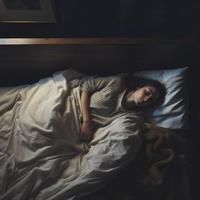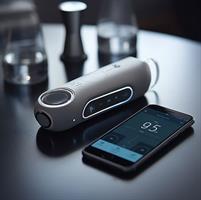Did you know that sleep apnea, a serious sleep disorder, can occur without the presence of loud snoring? In fact, many people wonder, “can you have sleep apnea without snoring?”
Recognizing the silent signs of sleep apnea is crucial for proper diagnosis and treatment, as it can lead to severe health complications if left untreated. Let’s dive into the world of sleep apnea without snoring and learn how to identify and manage this condition effectively.
Key Takeaways
-
Sleep apnea is a complex disorder with various forms and symptoms, including snoring or silence.
-
Although less common, it is possible to have sleep apnea without snoring.
-
Friends and family can provide understanding, encouragement, and support to those living with sleep apnea.
Sleep Apnea: Beyond the Noise
Sleep apnea is a prevalent sleep disorder characterized by episodes of cessation of breathing during sleep, affecting approximately 39 million American and 858,900 Canadian adults.
Although loud snoring is a common symptom of sleep apnea, it is possible for an individual to have sleep apnea without snoring. Comprehending the various forms of sleep apnea can aid in accurate diagnosis and treatment, as untreated conditions may result in a variety of health complications.
There are three types of sleep apnea: obstructive sleep apnea, central sleep apnea, and complex sleep apnea. Each type exhibits unique symptoms and risk factors, necessitating a diagnosis from a healthcare provider, such as a sleep specialist, to ensure proper treatment.
Obstructive Sleep Apnea
Obstructive sleep apnea is the most common type of sleep apnea snoring, affecting a large number of individuals. It occurs when the throat muscles relax during sleep, causing a blocked airway and resulting in loud snoring as a common symptom. Risk factors associated with obstructive sleep apnea include:
-
Obesity
-
Smoking
-
Alcohol consumption
-
Family history
Surgery is often the best choice for treating severely shut airways. It can provide long-term relief from breathing problems. However, less invasive approaches, such as control breathing, adjusting sleep position, or using continuous positive airway pressure (CPAP) therapy, can also help alleviate some symptoms of sleep apnea.
Central Sleep Apnea
Central sleep apnea, on the other hand, is a less common type of sleep apnea that occurs when the brain fails to send proper signals to the muscles controlling breathing during sleep. This results in episodes of stopped breathing, often without the presence of snoring. Risk factors associated with central sleep apnea include heart failure, stroke, and brain tumors.
The distinction between central sleep apnea and obstructive sleep apnea lies in the cause of the breathing pauses. While obstructive sleep apnea is caused by the collapse of throat muscles, central sleep apnea occurs due to the brain’s inability to transmit the correct signals to the muscles that control respiration.
Complex Sleep Apnea
Complex sleep apnea is a combination of both obstructive and central sleep apnea, making it a more challenging condition to diagnose and treat. This type of sleep apnea can be caused by a combination of factors, such as the interaction of upper airway obstruction and unstable central ventilatory control or when someone previously diagnosed with obstructive sleep apnea develops central sleep apnea due to CPAP treatment.
To diagnose sleep apnea, particularly complex sleep apnea, a diagnostic sleep study known as a polysomnogram is used. This study assesses the number of obstructive events, including obstructive apneas, mixed apneas, hypopneas, and respiratory-related arousals, that occur per hour of sleep. Indications of complex sleep apnea may include episodes of not breathing during sleep, sudden awakenings with shortness of breath, excessive daytime sleepiness, and feeling very tired during the day.
Undiagnosed sleep apnea can lead to these persistent symptoms and complications.
Silent Symptoms: Recognizing Sleep Apnea Without Snoring
Snoring is a common symptom associated with sleep apnea. In up to 94% of those with sleep apnea, snoring is present. However, it is possible to have sleep apnea without snoring.
Identifying sleep apnea in the absence of snoring requires noticing other symptoms, which may comprise:
-
Excessive daytime sleepiness
-
Repeated awakenings at night
-
Morning headaches
-
Concentration problems
-
Sore throats
-
Dry mouth upon waking up
If you or someone you know is experiencing these symptoms, it is important to consult with a healthcare professional to receive an accurate diagnosis and appropriate treatment for sleep apnea. Lifestyle alterations, such as maintaining a healthy weight and limiting certain activities during the night, may assist in mitigating risk factors and controlling symptoms of sleep apnea.
Diagnosing Sleep Apnea: What to Expect
Diagnosing sleep apnea may involve at-home sleep studies or in-lab sleep tests, where breathing patterns, oxygen levels, and heart rate are monitored and analyzed by a sleep specialist. Sleep oxygen monitors can be purchased and used at home. Home sleep apnea tests are cost-effective, covered by most major medical plans, and provide sleeping data while in the comfort of one’s own bed.
However, in some cases, at-home tests may not be comprehensive enough, and an in-person sleep study may be recommended to obtain additional information. Working closely with a primary care provider or sleep specialist is necessary for precisely modifying treatment and diligently tracking progress.
Treatment Options for Sleep Apnea: Finding the Right Approach
Various treatment options are available to treat sleep apnea, depending on the type, severity, and individual preferences. These may include positive airway pressure (PAP) therapy or oral appliances like snoring mouthpieces.
The type of sleep apnea, individual medical history, and lifestyle are all taken into consideration when devising a treatment plan for sleep apnea.
CPAP
CPAP therapy is a common treatment option for sleep apnea that uses a machine to deliver continuous air pressure to keep the airway open during sleep.
A CPAP machine is designed to deliver a continuous stream of air into the nose via a nose mask while sleeping, thereby maintaining an open airway and preventing apneas.
CPAP therapy is commonly perceived as the most efficacious treatment for obstructive sleep apnea. However, some patients may find adjusting to CPAP therapy to be challenging. In such cases, other treatment options, like oral appliances or lifestyle changes, may be explored.
Snoring Mouthpieces
Snoring mouthpieces, or oral appliances, may serve as an alternative treatment for individuals who are unable to tolerate CPAP therapy or are not suitable candidates for surgery.
Various snoring mouthpieces are available for sleep apnea, including:
Snoring mouthpieces can be comfortable to use for sleep apnea patients, although over-the-counter mouthpieces may cause discomfort since they are not tailored to the shape of one’s jaw and mouth.
Therefore, it is recommended to use custom-fitted mouthpieces for improved comfort and efficacy.
The Importance of Proper Diagnosis and Treatment
Accurate diagnosis and treatment of sleep apnea are imperative to prevent possible health complications and enhance the overall quality of life.
Untreated sleep apnea can lead to:
-
Increased risk of cardiovascular problems such as strokes and heart attacks
-
Type 2 diabetes
-
Metabolic syndrome
-
Complications with medications
-
Daytime fatigue
-
Death
Research indicates that continuous positive airway pressure (CPAP) devices in sleep apnea treatment can diminish the likelihood of cardiovascular events, enhance sleep quality, and preserve normal oxygen levels. This reduces heart strain and lowers the risk of conditions like hypertension, stroke, and heart attacks.
Furthermore, sleep apnea treatment has also been seen to reduce the progression or recurrence of atrial fibrillation, a common heart rhythm disorder associated with sleep apnea.
How to Support a Loved One With Sleep Apnea
Supporting a loved one with sleep apnea involves understanding their condition, encouraging them to seek professional help, and being patient as they adjust to treatment options.
As a friend or family member, you can play a significant part in aiding your loved one in managing their sleep apnea symptoms and sticking to their treatment plan.
Some suggestions for supporting a loved one with sleep apnea include:
-
Encouraging the utilization of a CPAP or dental appliance
-
Participating in physical activity together
-
Limiting food and beverages prior to sleep
-
Offering to be an exercise companion
By providing understanding, encouragement, and support, you can make a significant difference in the life of a loved one with sleep apnea.
Summary
In conclusion, recognizing the silent signs of sleep apnea is crucial for proper diagnosis and treatment. Understanding the different types of sleep apnea, including the possibility of sleep apnea without snoring, is essential for devising an appropriate treatment plan.
With the right support from friends, family, and healthcare professionals, individuals with sleep apnea can manage their symptoms effectively and improve their overall quality of life.
Frequently Asked Questions
How do I know if I have sleep apnea without snoring?
If you are experiencing restlessness during sleep, such as kicking, thrashing, jerking or waking up with disheveled sheets, it may be a sign of sleep apnea, even without snoring.
You can better determine if you have sleep apnea by undergoing a sleep study. Alternatively, you can monitor your own oxygen levels at night using a pulse oximeter. If your oxygen is low at night, it would most likely indicate a form of sleep apnea.
What can be mistaken for sleep apnea?
Sleep apnea is often mistaken for other conditions such as upper airway resistance syndrome, snoring, and even allergies. To make a correct diagnosis, it is important to be aware of the common misdiagnoses of sleep apnea.
What are the 4 types of sleep apnea?
Sleep apnea is categorized into four types: central, obstructive, complex and obstructive sleep apnea (OSA), with OSA being the most common form.
Do all sleep apnea patients snore?
While it is common for people with sleep apnea to snore, it is important to note that not everyone who has sleep apnea snores and not everyone who snores has sleep apnea.
Up to 20 percent of people who have sleep apnea may also experience other symptoms such as gasping for air, choking, and labored breathing.
Can someone have sleep apnea without snoring?
Yes, it is possible to have sleep apnea without snoring. Breathing pauses or difficulty in breathing during sleep can also be signs of sleep apnea, and should not be ignored.
References
- Sleep Apnea Statistics and Facts You Should Know. https://www.ncoa.org/adviser/sleep/sleep-apnea-statistics/
- The Dangers of Uncontrolled Sleep Apnea. https://www.hopkinsmedicine.org/health/wellness-and-prevention/the-dangers-of-uncontrolled-sleep-apnea





